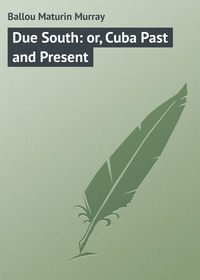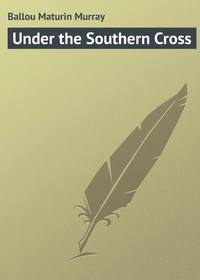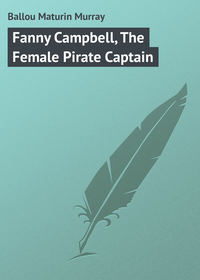 полная версия
полная версияEquatorial America
Though it no longer produces a single article of export on its own soil, St. Thomas was, in the days of negro slavery, one of the most prolific sugar yielding islands of this region. It will be remembered that the emancipation of the blacks took place here in 1848. It was never before impressed upon us, if we were aware of the fact, that the sugar-cane is not indigenous to the West Indies. It seems that the plant came originally from Asia, and was introduced into these islands by Columbus and his followers. As is often the case with other representatives of the vegetable kingdom, it appears to have flourished better here than in the land of its nativity, new climatic combinations, together with the soil, developing in the saccharine plant better qualities and increased productiveness, for a long series of years enriching many enterprising planters.
When Columbus discovered St. Thomas, in 1493, it was inhabited by two tribes of Indians, the Caribs and the Arrowauks, both of which soon disappeared under the oppression and hardships imposed by the Spaniards. It is also stated that from this island, as well as from Cuba and Hayti, many natives were transported to Spain and there sold into slavery, in the days following close upon its discovery. Thus Spain, from the earliest date, characterized her operations in the New World by a heartlessness and injustice which ever attended upon her conquests, both among the islands and upon the continent of America. The Caribs were of the red Indian race, and appear to have been addicted to cannibalism. Indeed, the very word, by which the surrounding sea is also known, is supposed to be a corruption of the name of this tribe. "These Caribs did not eat their own babies," says an old writer apologetically, "like some sorts of wild beasts, but only roasted and ate their prisoners of war."
The island was originally covered with a dense forest growth, but is now comparatively denuded of trees, leaving the land open to the full force of the sun, and causing it to suffer at times from serious droughts. There is said to be but one natural spring of water on the island. This shows itself at the surface, and is of very limited capacity; the scanty rains which occur here are almost entirely depended upon to supply water for domestic use.
St. Thomas being so convenient a port of call for steamers from Europe and America, and having so excellent a harbor, is improved as a depot for merchandise by several of the neighboring islands, thus enjoying a considerable commerce, though it is only in transitu. It is also the regular coaling station of several steamship lines. Judging from appearances, however, it would seem that the town is not growing in population or business relations, but is rather retrograding. The value of the imports in 1880 was less than half the aggregate amount of 1870. We were told that green groceries nearly all come from the United States, and that even eggs and poultry are imported from the neighboring islands, showing an improvidence on the part of the people difficult to account for, since these sources of food supply can be profitably produced at almost any spot upon the earth where vegetation will grow. Cigars are brought hither from Havana in considerable quantities, and having no duty to pay, can be sold very cheap by the dealers at St. Thomas, and still afford a reasonable profit. Quite a trade is thus carried on with the passengers of the several steamers which call here regularly, and travelers avail themselves of the opportunity to lay in an ample supply. Cuban cigars of the quality which would cost nine or ten dollars a hundred in Boston are sold at St. Thomas for five or six dollars, and lower grades even cheaper in proportion. There is said to be considerable smuggling successfully carried on between this island and the Florida shore, in the article of cigars as well as in tobacco in the unmanufactured state. The high duty on these has always incited to smuggling, thus defeating the very object for which it is imposed. Probably a moderate duty would yield more to the government in the aggregate, by rendering it so much less of an object to smuggle.
Though the island is Danish in nationality, there are few surroundings calculated to recall the fact, save that the flag of that country floats over the old fort and the one or two official buildings, just as it has done for the last two centuries. The prominent officials are Danes, as well as the officers of the small body of soldiers maintained on the island. English is almost exclusively spoken, though there are French, Spanish, and Italian residents here. English is also the language taught in the public schools. People have come here to make what money they can, but with the fixed purpose of spending it and enjoying it elsewhere. As a rule, all Europeans who come to the West Indies and embark in business do so with exactly this purpose. In Cuba the Spaniards from the continent, among whom are many Jews, have a proverb the significance of which is: "Ten years of starvation, and a fortune," and most of them live up to this axiom. They leave all principles of honor, all sense of moral responsibility, all sacred domestic ties, behind them, forgetting, or at least ignoring, the significant query, namely, "What shall it profit a man, if he gain the whole world, and lose his own soul?"
About one third of the population is Roman Catholic. The Jews have a synagogue, and a membership of six hundred. They have a record on the island dating as far back as the year 1757, and add much to the activity and thrift of St. Thomas. No matter where we find the Jews, in Mexico, Warsaw, California, or the West Indies, they are all alike intent upon money making, and are nearly always successful. Their irrepressible energy wins for them the goal for which they so earnestly strive. That soldier of fortune, Santa Anna, formerly ruler of Mexico, when banished as a traitor from his native country, made his home on this island, and the house which he built and occupied is still pointed out to visitors as one of the local curiosities. The social life of St. Thomas is naturally very circumscribed, but is good so far as it goes. A few cultured people, who have made it their home for some years, have become sincerely attached to the place, and enjoy the climate. There are a small public library, a hospital, several charitable institutions, and a theatre, which is occupied semi-occasionally. The island is connected with the continent by cable, and has a large floating dock and marine railway, which causes vessels in distress to visit the port for needed repairs. The town is situated on the north side of the bay which indents the middle of the south side of the island. The harbor has a depth of water varying from eighteen to thirty-six feet, and has the advantage of being a free port, a fact, perhaps, of not much account to a place which has neither exports nor imports of its own. St. Thomas is the only town of any importance on the island, and is known locally as Charlotte Amalie, a fact which sometimes leads to a confusion of ideas.
The reader need not encounter the intense heat, which so nearly wilted us, in an effort to obtain a good lookout from some elevated spot; but the result will perhaps interest him, as it fully repaid the writer for all the consequent discomfort.
From the brow of a moderate elevation just behind the town, a delightful and far-reaching view is afforded, embracing St. Thomas in the foreground, the well-sheltered bay, dotted with vessels bearing the flags of various nations, an archipelago of islets scattered over the near waters, and numerous small bays indenting the coast. At a distance of some forty miles across the sea looms the island of Santa Cruz; and farther away, on the horizon's most distant limit, are seen the tall hills and mountains of Porto Rico; while the sky is fringed by a long trailing plume of smoke, indicating the course of some passing steamship. The three hills upon which the town stands are spurs of West Mountain, and the place is quite as well entitled to the name of Tremont – "tri-mountain" – as was the capital of Massachusetts, before its hills were laid low to accommodate business demands. On the seaward side of these elevations the red tiled roofs of the white houses rise in regular terraces from the street which borders the harbor, forming a very picturesque group as seen from the bay.
Though it has not often been visited by epidemics, Mr. Anthony Trollope pronounces the island, in his usual irresponsible way, to be "one of the hottest and one of the most unhealthy spots among all these hot and unhealthy regions," and adds that he would perhaps be justified in saying "that of all such spots it is the hottest and most unhealthy." This is calculated to give an incorrect idea of St. Thomas. True, it is liable to periods of unhealthiness, when a species of low fever prevails, proving more or less fatal. This is thought to originate from the surface drainage, and the miasma arising from the bay. All the drains of the town flow into the waters of the harbor, which has not sufficient flow of tide to carry seaward the foul matter thus accumulated. The hot sun pouring its heat down upon this tainted water causes a dangerous exhalation. Still, sharks do not seem to be sensitive as to this matter, for they much abound. It is yet to be discovered why these tigers of the sea do not attack the negroes, who fearlessly leap overboard; a white man could not do this with impunity. The Asiatics of the Malacca Straits do not enjoy any such immunity from danger, though they have skins as dark as the divers of St. Thomas. Sharks appear in the West Indies in small schools, or at least there are nearly always two or three together, but in Oriental waters they are only seen singly. Thus a Malay of Singapore, for a compensation, say an English sovereign, will place a long, sharp knife between his teeth and leap naked into the sea to attack a shark. He adroitly dives beneath the creature, and as it turns its body to bring its awkward mouth into use, with his knife the Malay slashes a deep, long opening in its exposed belly, at the same time forcing himself out of the creature's reach. The knife is sure and fatal. After a few moments the huge body of the fish is seen to rise and float lifeless upon the surface of the water.
A large majority of the people are colored, exhibiting some peculiarly interesting types, intermarriage with whites of various nationalities having produced among the descendants of Africans many changes of color and of features. One feels sure that there is also a trace of Carib or Indian blood mingled with the rest, – a trace of the aborigines whom Columbus found here. The outcome is not entirely a race with flat noses and protruding lips; straight Grecian profiles are not uncommon, accompanied by thin nostrils and Anglo-Saxon lips. Faultless teeth, soft blue eyes, and hair nearly straight are sometimes met with among the creoles. As to the style of walking and of carrying the head and body, the common class of women of St. Thomas have arrived at perfection. Some of them are notable examples of unconscious dignity and grace combined. This has been brought about by carrying burdens upon their heads from childhood, without the supporting aid of the hands. Modesty, or rather conventionality, does not require boys or girls under eight years of age to encumber themselves with clothing. The costume of the market women and the lower classes generally is picturesque, composed of a Madras kerchief carefully twisted into a turban of many colors, yellow predominating, a cotton chemise which leaves the neck and shoulders exposed, reaching just below the knees, the legs and feet being bare. The men wear cotton drawers reaching nearly to the knee, the rest of the body being uncovered, except the head, which is usually sheltered under a broad brimmed straw hat, the sides of which are perforated by many ventilating holes. The whites generally, and also the better class of natives, dress very much after the fashion which prevails in North America.
This is the negroes' paradise, but it is a climate in which the white race gradually wanes. The heat of the tropics is modified by the constant and grateful trade winds, a most merciful dispensation, without which the West Indies would be uninhabitable by man. On the hillsides of St. Thomas these winds insure cool nights at least, and a comparatively temperate state of the atmosphere during the day. Vegetation is abundant, the fruit trees are perennial, bearing leaf, blossom, and fruit in profusion, month after month, year after year. Little, if any, cultivation is required. The few sugar plantations which are still carried on yield from three to four successive years without replanting. It is a notable fact that where vegetation is at its best, where the soil is most rank and prolific, where fruits and flowers grow in wild exuberance, elevated humanity thrives the least. The lower the grade of man, the nearer he approximates to the animals, the less civilized he is in mind and body, the better he appears to be adapted to such localities. The birds and the butterflies are in exact harmony with the loveliness of tropical nature, however prolific she may be; the flowers are glorious and beautiful: it is man alone who seems out of place. A great variety of fruits are indigenous here, such as the orange, lime, alligator pear, moss-apple, and mango, but none of them are cultivated to any extent; the people seem to lack the energy requisite to improve the grand possibilities of their fertile soil and prolific climate.
We were reminded by a resident of the town, before we left the harbor of St. Thomas, that the nervous old lady referred to was not entirely without reason for her anxiety. Some of our readers will remember, perhaps, that in October, 1867, a most disastrous hurricane swept over these Virgin Islands, leaving widespread desolation in its track. The shipping which happened to be in the bay of St. Thomas was nearly all destroyed, together with hundreds of lives, while on the land scores of houses and many lives were also sacrificed to the terrible cyclone of that date. Even the thoroughly built iron and stone lighthouse was completely obliterated. There is a theory that such visitations come in this region about once in every twelve or fifteen years, and upon looking up the matter we find them to have occurred, with more or less destructive force, in the years 1793, 1819, 1837, 1867, 1871, and so late as August, 1891. Other hurricanes have passed over these islands during the period covered by these dates, but of a mitigated character. August, September, and October are the months in which the hurricanes are most likely to occur, and all vessels navigating the West Indian seas during these months take extra precautions to secure themselves against accidents from this source. When such visitations happen, the event is sure to develop heroic deeds. In the hurricane of 1867, the captain of a Spanish man-of-war, who was a practical sailor, brought up from boyhood upon the ocean, seeing the oncoming cyclone, and knowing by experience what to expect, ordered the masts of his vessel to be cut away at once, and every portion of exposed top hamper to be cast into the sea. When thus stripped he exposed little but the bare hull of his steamer to the fury of the storm. After the cyclone had passed, it was found that he had not lost a man, and that the steamer's hull, though severely battered, was substantially unharmed. Keeping up all steam during the awful scene, this captain devoted himself and his ship to the saving of human life, promptly taking his vessel wherever he could be of the most service. Hundreds of seamen were saved from death by the coolness and intrepidity of this heroic sailor.
Since these notes were written among the islands, a terrible cyclone has visited them. This was on August 18, last past, and proved more destructive to human life, to marine and other property, than any occurrence of the kind during the last century. At Martinique a sharp shock of earthquake added to the horror of the occasion, the town of Fort de France being very nearly leveled with the ground. Many tall and noble palms, the growth of half a hundred years, were utterly demolished in the twinkling of an eye, and other trees were uprooted by the score.
The waters of this neighborhood teem with strange forms of animal and vegetable life. Here we saw specimens of red and blue snappers, the angel-fish, king-fish, gurnets, cow-fish, whip-ray, peacock-fish, zebra-fish, and so on, all, or nearly all, unfamiliar to us, each species individualized either in shape, color, or both. The whip-ray, with a body like a flounder, has a tail six or seven feet long, tapering from an inch and over to less than a quarter of an inch at the small end. When dried, it still retains a degree of elasticity, and is used by the natives as a whip with which to drive horses and donkeys. In some places, so singularly clear is the water that the bottom is distinctly visible five or six fathoms below the surface, where fishes of various sorts are seen in ceaseless motion. White shells, corals, star-fish, and sea-urchins mingle their various forms and colors, objects and hues seeming to be intensified by the strong reflected light from the surface, so that one could easily fancy them to be flowers blooming in the fairy gardens of the mermaids. The early morning, just after the sun begins to gild the surface of the sea, is the favorite time for the flying-fishes to display their aerial proclivities. They are always attracted by a strong light, and are thus lured to their destruction by the torches of the fishermen, who often go out for the purpose at night and take them in nets. In the early morning, as seen from the ship's deck, they scoot above the rippling waves in schools of a hundred and more, so compact as to cast fleeting shadows over the blue enameled surface of the waters. At St. Thomas, Martinique, and Barbadoes, as well as among the other islands bordering the Caribbean Sea, they form no inconsiderable source of food for the humble natives, who fry them in batter mixed with onions, making a savory and nutritious dish.
St. Thomas is, as we have said, a coaling station for steamships, and when the business is in progress a most unique picture is presented. The ship is moored alongside of the dock for this purpose, two side ports being thrown open, one for ingress, the other for egress. A hundred women and girls, wearing one scanty garment reaching to the knees, are in line, and commence at once to trot on board in single file, each one bearing a bushel basket of coal upon her head, weighing, say sixty pounds. Another gang fill empty baskets where the coal is stored, so that there is a continuous line of negresses trotting into the ship at one port and, after dumping their loads into the coal bunkers, out at the other, hastening back to the source of supply for more. Their step is quick, their pose straight as an arrow, while their feet keep time to a wild chant in which all join, the purport of which it is not possible to clearly understand. Now and again their voices rise in softly mingled harmony, floating very sweetly over the still waters of the bay. The scene we describe occurred at night, but the moon had not yet risen. Along the wharf, to the coal deposits, iron frames were erected containing burning bituminous coal, and the blaze, fanned by the open air, formed the light by which the women worked. It was a weird picture. Everything seemed quite in harmony: the hour, the darkness of night relieved by the flaming brackets of coal, the strange, dark figures hastening into the glare of light and quickly vanishing, the harmony of high-pitched voices occasionally broken in upon by the sharp, stern voice of their leader, – all was highly dramatic and effective.
Not unfrequently three or four steamers are coaling at the same time from different wharves. Hundreds of women and girls of St. Thomas make this labor their special occupation, and gain a respectable living by it, doubtless supporting any number of lazy, worthless husbands, fathers, and brothers.
After our ship was supplied with coal, these women, having put three hundred tons on board in a surprisingly short period of time, formed a group upon the wharf and held what they called a firefly dance, indescribably quaint and grotesque, performed by the flickering light of the flaming coal. Their voices were joined in a wild, quick chant, as they twisted and turned, clapping their hands at intervals to emphasize the chorus. Now and again a couple of the girls would separate from the rest for a moment, then dance toward and from each other, throwing their arms wildly about their heads, and finally, gathering their scanty drapery in one hand and extending the other, perform a movement similar to the French cancan. Once more springing back among their companions, all joined hands, and a roundabout romp closed the firefly dance. Could such a scene be produced in a city theatre au naturel, with proper accessories and by these actual performers, it would surely prove an attraction good for one hundred nights. Of course this would be impossible. Conventionality would object to such diaphanous costumes, and bare limbs, though they were of a bronzed hue, would shock Puritanic eyes.
Upon first entering the harbor, the Vigilancia anchored at a short distance from the shore; but when it became necessary to haul alongside the wharf, the attempt was made to get up the anchor, when it was found to require far more than the usual expenditure of power to do so. Finally, however, the anchor was secured, but attached to its flukes there came also, from the bottom of the bay, a second anchor, of antique shape, covered with rust and barnacles. It was such a one as was carried by the galleons of the fifteenth century, and had doubtless lain for over four hundred years just where the anchor of our ship had got entangled with it. What a remarkable link this corroded piece of iron formed, uniting the present with the far past, and how it stimulated the mind in forming romantic possibilities! It may have been the holding iron of Columbus's own caravel, or have been the anchor of one of Cortez's fleet, which touched here on its way into the Gulf of Mexico, or, indeed, it may have belonged to some Caribbean buccaneer, who was obliged to let slip his cable and hasten away to escape capture.
It was deemed a fortunate circumstance to have secured this ancient relic, and a sure sign of future good luck to the ship, so it was duly stored away in the lower hold of the Vigilancia.
That same night on which the coal bunkers were filled, our good ship was got under way, while the rising moon made the harbor and its surroundings as clearly visible as though it were midday. The light from the burning coal brackets had waned, only a few sparks bursting forth now and again, disturbed by a passing breeze which fanned them into life for a moment. When we passed through the narrow entrance by the lighthouse, and stood out once more upon the open sea, it was mottled, far and near, with argent ripples, that waltzed merrily in the soft, clear moonlight, rivaling the firefly dance on shore. Even to the very horizon the water presented a white, silvery, tremulous sheen of liquid light. One gazed in silent enjoyment until the eyes were weary with the lavish beauty of the scene, and the brain became giddy with its splendor. Is it idle and commonplace to be enthusiastic? Perhaps so; but we hope never to outlive such inspiration.
CHAPTER II
Curious Seaweed. – Professor Agassiz. – Myth of a Lost Continent. – Island of Martinique. – An Attractive Place. – Statue of the Empress Josephine. – Birthplace of Madame de Maintenon. – City of St. Pierre. – Mont Pelée. – High Flavored Specialty. – Grisettes of Martinique. – A Botanical Garden. – Defective Drainage. – A Fatal Enemy. – A Cannibal Snake. – The Climate.
Between St. Thomas and the island of Martinique, we fell in with some floating seaweed, so peculiar in appearance that an obliging quartermaster picked up a spray for closer examination. It is a strange, sponge-like plant, which propagates itself on the ocean, unharmed by the fiercest agitation of the waves, or the wildest raging of the winds, at the same time giving shelter to zoöphytes and mollusks of a species, like itself, found nowhere else. Sailors call it Gulf weed, but it has nothing to do with the Gulf Stream, though sometimes clusters get astray and are carried far away on the bosom of that grand ocean current. The author has seen small bodies of it, after a fierce storm in the Caribbean Sea, a thousand miles to the eastward of Barbadoes. Its special home is a broad space of ocean surface between the Gulf Stream and the equatorial current, known as the Sargasso Sea. Its limits, however, change somewhat with the seasons. It was first noticed by Columbus in 1492, and in this region it has remained for centuries, even to the present day. Sometimes this peculiar weed is so abundant as to present the appearance of a submerged meadow, through which the ship ploughs its way as though sailing upon the land. We are told that Professor Agassiz, while at sea, having got possession of a small branch of this marine growth, kept himself busily absorbed with it and its products for twelve hours, forgetting all the intervening meals. Science was more than food and drink to this grand savant. His years from boyhood were devoted to the study of nature in her various forms. "Life is so short," said he, "one can hardly find space to become familiar with a single science, much less to acquire knowledge of many." When he was applied to by a lyceum committee to come to a certain town and lecture, he replied that he was too busy. "But we will pay you double price, Mr. Agassiz, if you will come," said the applicant. "I cannot waste time to make money," was the noble reply.











